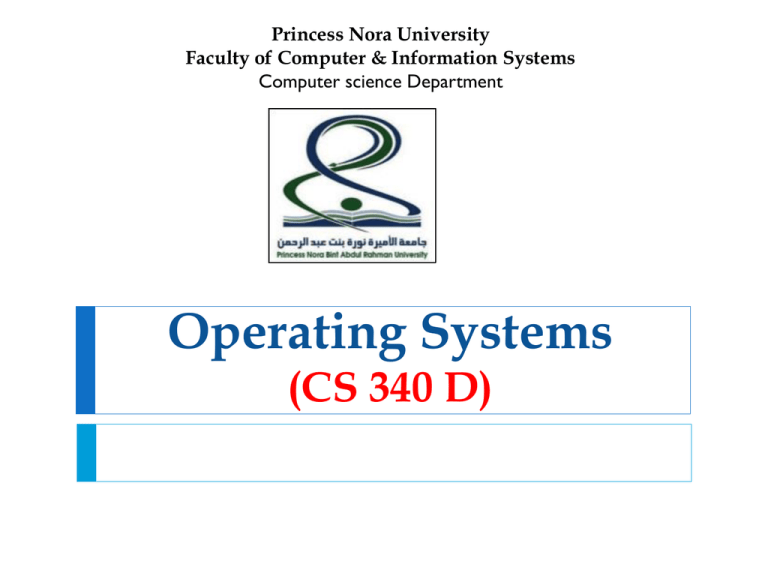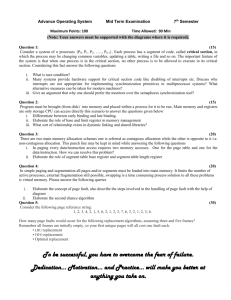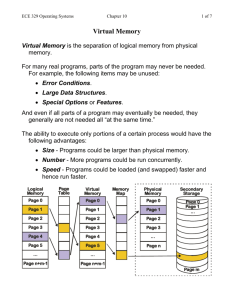07-ch9-Virtual Memory - pnu-cs-os
advertisement

Princess Nora University Faculty of Computer & Information Systems Computer science Department Operating Systems (CS 340 D) (Chapter-9) Virtual Memory Chapter 9: Virtual Memory 1. Background 2. Virtual Memory Implementation 3 OBJECTIVES: To describe the benefits of a virtual memory system To explain the concepts of demand paging To explain the concepts of page-replacement algorithms 4 Background 5 Background In chapter of memory management , various memory-management strategies used in computer systems were discussed and all of these strategies have the same goal: to keep many processes in memory simultaneously to allow multiprogramming. However, they tend to require that an entire process be in memory before it can execute. Virtual memory is a technique that allows the execution of processes that are not completely in memory. 6 Background Advantages 1. programs can be larger than physical memory. 2. Map main memory into an extremely large, uniform array of storage, 3. separating logical memory as viewed by the user from physical memory. 4. This technique frees programmers from the concerns of memorystorage limitations. Virtual Memory That is Larger Than Physical Memory 7 Background Advantages (cont) o Virtual memory also allows processes to share files easily and to implement shared memory. Shared Library Using Virtual Memory 8 Background Disadvantage 9 Virtual memory is not easy to implement, however, and may substantially decrease performance if it is used carelessly Virtual Memory Implementation Demand Paging 10 Virtual memory can be implemented via: 1. 2. 11 Demand paging Demand segmentation 1-Demand Paging Consider how an executable program might be loaded from disk into memory. One option is to load the entire program in physical memory at program execution time. However, a problem with this approach is that we may not initially need the entire program in memory. Ex: Suppose a program starts with a list of available options from which the user is to select. Loading the entire program into memory results in loading the executable code for all options, regardless of whether an option is ultimately selected by the user or not. An alternative strategy is to load pages only as they are needed during program excution. This technique is known as demand paging and is commonly used in virtual memory systems. 12 1-Demand Paging A demand-paging system is similar to a paging system with swapping But rather than swapping the entire process into memory, we use a lazy swapper. lazy swapper never swaps a page into memory unless that page will be needed. Since we are now viewing a process as a sequence of pages, rather than as one large contiguous address space, use of the term swapper is technically incorrect. A swapper manipulates entire processes, whereas a pager is concerned with the individual pages of a process. We thus use pager, rather than swapper, in connection with demand paging. 13 1-Demand Paging 14 Bring a page into memory only when it is needed Less I/O needed Less memory needed Faster response More users Page is needed reference to it invalid reference abort not-in-memory bring to memory Transfer of a Paged Memory to Contiguous Disk Space 15 1-Demand Paging (cont..) With this scheme, we need some form of hardware support to distinguish between 1. the pages that are in memory 2. the pages that are on the disk. The valid–invalid bit scheme can be used for this purpose. “valid,” : the associated page is both legal and in memory. “invalid,” the page either is not valid (that is, not in the logical address space of the process) or is valid but is currently on the disk. 16 1-Demand Paging(cont..) Valid-Invalid Bit With each page table entry a valid– invalid bit is associated (v in-memory, i not-in-memory) Initially valid–invalid bit is set to i on all entries 17 page table Page Table When Some Pages Are Not in Main Memory 18 Page Fault 1. 2. 3. 4. 5. 6. If there is a reference to a page, first reference to that page will trap to operating system: page fault Operating system looks at another table to decide: Invalid reference abort Just not in memory Get empty frame Swap page into frame Reset tables Set validation bit = v Restart the instruction that caused the page fault 19 Steps in Handling a Page Fault 20 Performance of Demand Paging Demand paging can significantly affect the performance of a computer system. why ? • if no page faults, the effective access time is equal to the memory access time. • If, however, a page fault occurs, we must first read the relevant page from disk and then access the desired word. Let p be the probability of a page fault (0 ≤ p ≤ 1). expect p to be close to only a few page faults. effective access time = (1 − p) × ma + p × page fault time. 21 Demand Paging Example Memory access time = 200 nanoseconds Average page-fault service time = 8 milliseconds EAT = (1 – p) x 200 + p (8 milliseconds) = (1 – p x 200 + p x 8,000,000 = 200 + p x 7,999,800 If one access out of 1,000 causes a page fault, then EAT = 8.2 microseconds. This is a slowdown by a factor of 40!! 22 Page Replacement Algorithms 23 Page Replacement If we increase our degree of multiprogramming, we are overallocating memory. Ex: If we run six processes, each of which is ten pages in size but actually uses only five pages, we have higher CPU utilization and throughput, with ten frames to spare. It is possible, however, that each of these processes, for a particular data set, may suddenly try to use all ten of its pages, resulting in a need for sixty frames when only forty are available. Further, consider that system memory is not used only for holding program pages. Buffers for I/O also consume a considerable amount of memory. This use can increase the strain on memoryplacement algorithms. 24 Need For Page Replacement 25 Basic Page Replacement 1. Find the location of the desired page on disk 2. Find a free frame: - If there is a free frame, use it - If there is no free frame, use a page replacement algorithm to select a victim frame 3. Bring the desired page into the (newly) free frame; update the page and frame tables 4. Restart the process 26 Page Replacement 27 Page Replacement Algorithms 1. 2. 3. 28 FIFO Page Replacement Optimal Page Replacement Least Recently Used (LRU) Algorithm FIFO Page Replacement 29 FIFO Page Replacement algorithm The simplest page-replacement algorithm is a first-in, first- out (FIFO) FIFO each page has memory load start time or create FIFO queue to hold all pages in memory When a page must be replaced, the oldest page is chosen. 30 FIFO Page Replacement 31 Optimal Page Replacement 32 Optimal Algorithm Replace page that will not be used for longest period of time 4 frames example 1, 2, 3, 4, 1, 2, 5, 1, 2, 3, 4, 5 1 4 2 3 4 5 How do you know this? Used for measuring how well your algorithm performs Not easy to implement 33 Optimal Page Replacement 34 Least Recently Used (LRU) Page Replacement 35 Least Recently Used (LRU) Algorithm Reference string: 1, 2, 3, 4, 1, 2, 5, 1, 2, 3, 4, 5 1 1 1 1 5 2 2 2 2 2 3 5 5 4 4 4 4 3 3 3 Counter implementation o o 36 Every page entry has a counter; every time page is referenced through this entry, copy the clock into the counter When a page needs to be changed, look at the counters to determine which are to change LRU Page Replacement 37 LRU Algorithm (Cont.) Stack implementation – keep a stack of page numbers in a double link form: Page referenced: move it to the top requires 6 pointers to be changed No search for replacement 38 Thank you End of Chapter 9 39







